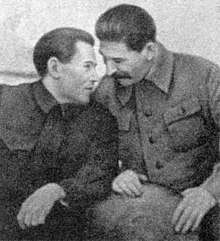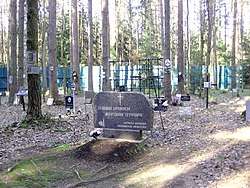Latvian Operation of the NKVD
The so-called Latvian Operation of the NKVD (Russian: Латышская операция НКВД, Latvian: NKVD "Latviešu operācija") was a mass arrest, execution and deportations of persons of Latvian origin in the Soviet Union by the People's Commissariat for Internal Affairs during the period of Great Purge (1937–1938).
| Latvian Operation of the NKVD | |
|---|---|
| Part of the Great Purge | |
 Nikolai Yezhov and Stalin, USSR, 1937 | |
| Location | |
| Date | 1937–1938 |
| Target | Latvians and others |
Attack type | Ethnic cleansing Prison shootings |
| Deaths | 16,573 |
| Perpetrators | Soviet NKVD |

Latvians in the Soviet Union until 1936
More than 500 Latvian peasant colonies originating from the 19th century following the abolition of serfdom existed near St. Petersburg, Novgorod and in Siberia. As the front line was approaching Courland in the First World War, extensive forced evacuations were carried out, so that the number of Latvians living in Russia doubled to nearly 500,000. Many of the Latvian Riflemen were early supporters of the Bolsheviks in 1917. With the end of the First World War and the Russian Civil War, many of the refugees were able to return to independent Latvia. The Treaty of Riga provided explicitly for the repatriation of former Latvian riflemen and refugees.
According to the 1926 census, about 150,000 Latvians remained in the Soviet Union. They cultivated a lively cultural life with the schools, newspapers and theaters. Since the 1905 Revolution, there was a strong Latvian faction in the Russian Social Democratic Labour Party. Persons of Latvian descent temporarily held high positions in the State apparatus of Soviet Russia. Of the 70 Cheka commissars in 1918, 38 were of Latvian descent.
However, with the increasing Russification of Russia's state organs, members of non-Russian minorities were largely ousted from management positions. Under the leadership of Josef Stalin, Latvia was regarded as a so-called "enemy nation" and Latvians were generally regarded as counter-revolutionary and suspicious elements. The resistance of Latvian peasant colonists to forced collectivization at the end of the 1920s seemed to bear out this image.
Through targeted deportations to the Gulag, such colonies were eliminated by 1933. A rigorous purge of the party and state apparatus of non-Russians began at that time. The Latvian Communist Party was dissolved in 1936, its members being persecuted and murdered as "nationalists" and "enemies of the people". One aspect of Stalin's Great Purge was state-directed xenophobia. In July 1937 the publishing house and cultural association "Prometejs" was closed and its employees arrested. The Red Latvian Riflemen were removed from history books and school text books and their veteran associations were dissolved.
The operation
On 23 November 1937, Nikolai Yezhov ordered the NKVD services to pool all the information gathered about Latvians in cultural and political life, the military and other institutions, so as to be able to arrest them "just as during the Polish operation".
On 30 November, in keeping with Order No. 49990, ethnic Latvians throughout the Soviet Union were arrested. The legal process was streamlined by standardized accusations and confessions, which resulted in sentences that the accused was remanded to penal camps or to be shot. Through torture, the NKVD constructed the existence of a Latvian espionage ring, which allegedly included all Latvian officials from the Politburo down to the school directors. The last Latvian Chekists were executed by their former colleagues.
Large groups of victims were shot at the shooting ranges of Butovo and Kommunarka near Moscow, in Levashovo near Leningrad or in Kurapaty near Minsk. However, the torture and murder in the framework of this operation took place throughout the Soviet Union.
Given the large number of detainees, the courts were unable to convict them quickly enough, despite the so-called album procedure. The date of completion of the operation was thus extended until August 1938. In October 1938, special Troikas were then set up to deal with the backlog of unprocessed cases.
The Latvian operation ended when Yezhov's successor, Lavrenty Beria issued NKVD Order No. 00762 on November 26, 1938, marking the end of the massive repressions of the Great Purge. The liquidation of the Latvian party officials caused certain difficulties for the Soviet authorities when they sought to establish a party and administrative apparatus during the occupation of Latvia 1940.
Results

The convictions of 22,369 Latvians are known, 16,573 or 74% of whom were shot. Various estimates are based on 73,000 Latvian casualties. The exact number of the victims are unknown because many other people who were murdered during the operation were not Latvian: These included spouses of persons sent to the Gulag because of their marriage with ethnic enemies as well as the children from such unions, who were sent to orphanages were not included in the statistics.
Information about specific deaths and dates could only be obtained after the end of the communist regime after 1991. The persons who carried out the operation, often known by name, have never been held accountable.
The operation led the remaining Latvians to abandon their culture so that the descendants of the Latvians in Russia barely speak Latvian today. The victims of the operation were rehabilitated under Khrushchev.
Notable victims
- Yuri Aplok (Juris Aploks)
- Ernest Appoga (Ernests Apoga)
- Yakov Alksnis (Jēkabs Alksnis)
- Karl Bauman (Kārlis Baumanis)
- Reinholds Bērziņš
- Yan Karlovich Berzin (Jānis Bērziņš)
- Jūlijs Daniševskis
- Aleksandr Drevin (Aleksandrs Drēviņš)
- Robert Eikhe (Roberts Eihe)
- Aleksandr Eiduk (Aleksandrs Eiduks)
- Gustav Klutsis (Gustavs Klucis)
- Vilhelm Knorin (Vilhelms Knoriņš)
- Martin Latsis (Mārtiņš Lācis)
- Marija Leiko
- Ivan Mezhlauk (Jānis Mežlauks)
- Valery Mezhlauk (Valērijs Mežlauks)
- Yakov Peters (Jēkabs Peterss)
- Yan Rudzutak (Jānis Rudzutaks)
- Ivan Strod (Jānis Strods)
- Jukums Vācietis
See also
- German operation of the NKVD
- Polish operation of the NKVD
References
Literature
- Pārsla Eglīte u.a.: "Latviešu akcija" PSRS 1937–1938. Museum of the Occupation of Latvia, 2007, ISBN 978-9984-9931-5-7.
- Björn M. Felder: Lettland im Zweiten Weltkrieg: Zwischen sowjetischen und deutschen Besatzern 1940–1946. Schöningh, 2009, ISBN 978-3-506-76544-4.
- Aivars Beika: Latvieši Padomju Savienībā. Komunistiskā genocīda upuri 1929–1939. In: Latvijas Okupācijas muzeja gadagrāmata; 1: 1999. Riga 2000.
- Anna Kaminsky: Erinnerungsorte an den Massenterror 1937/38: Russische Föderation. Bundesstiftung zur Aufarbeitung der SED Diktatur, 2007, ISBN 978-3-00-022887-2.
Documentary film
- Dzintra Geka: Stacija Latvieši 1937. Studija SB 2011.
External links
- „Der Große Terror“: 1937-1938 . Kurz-Chronik (The Great Terror: 1937–1938. A Brief Chronology.)